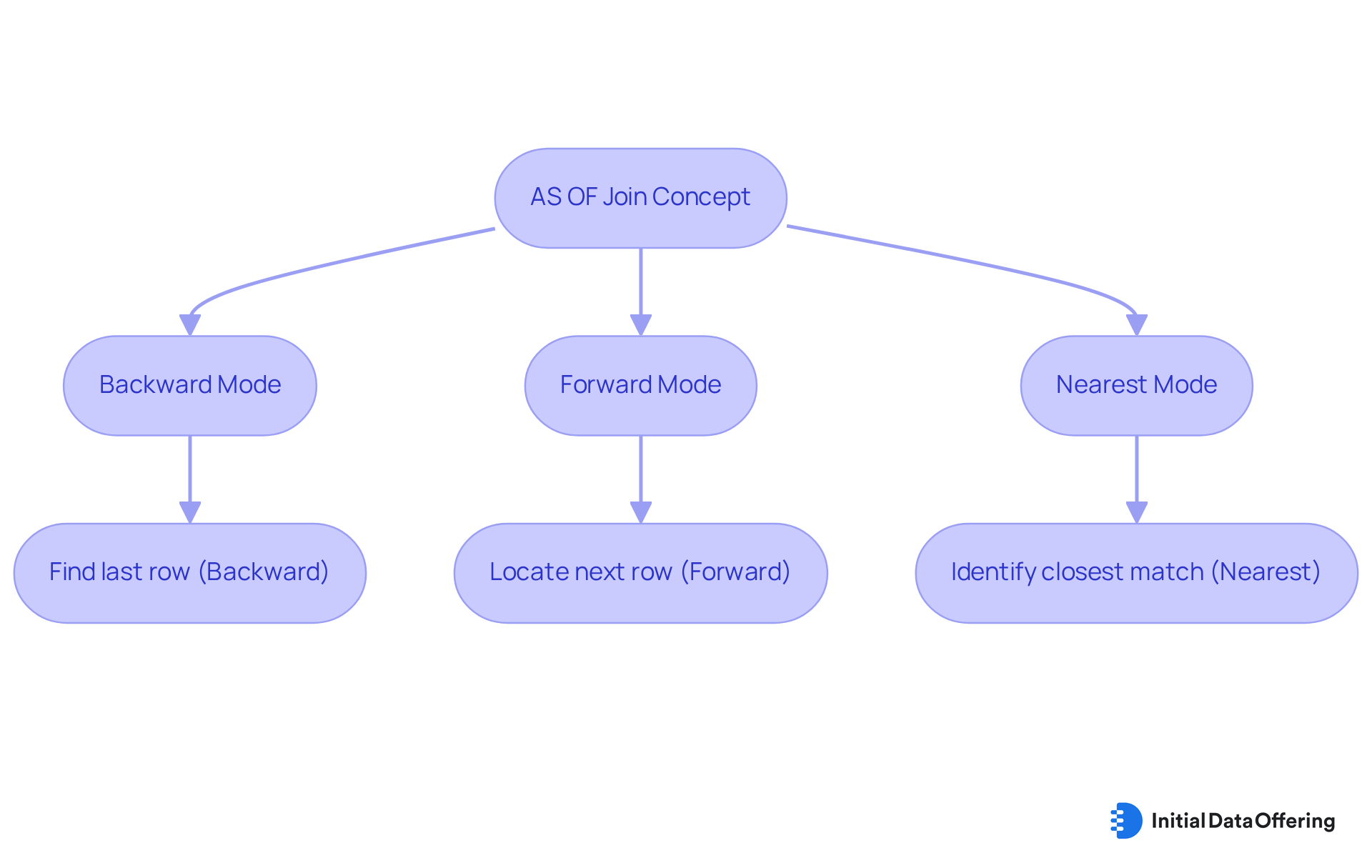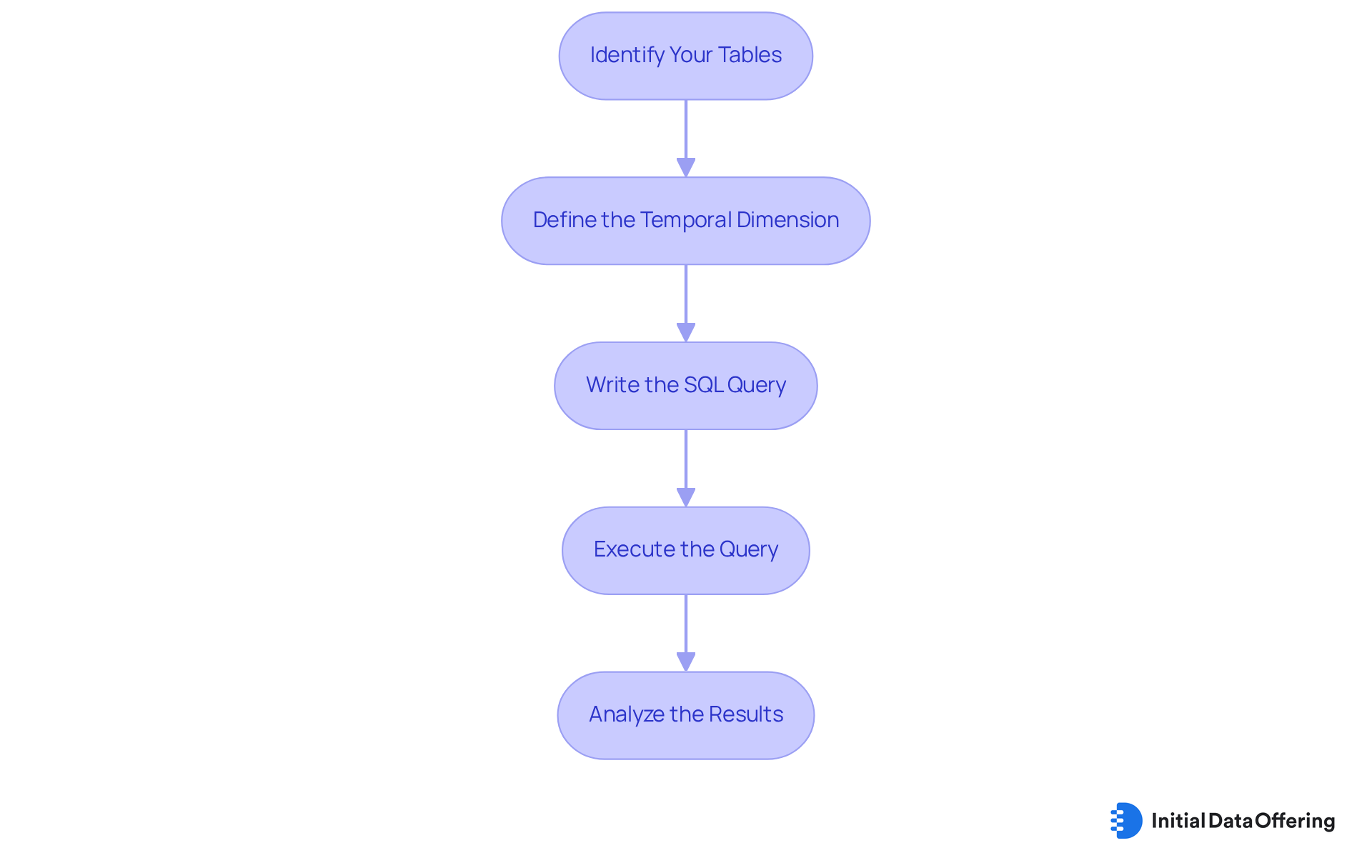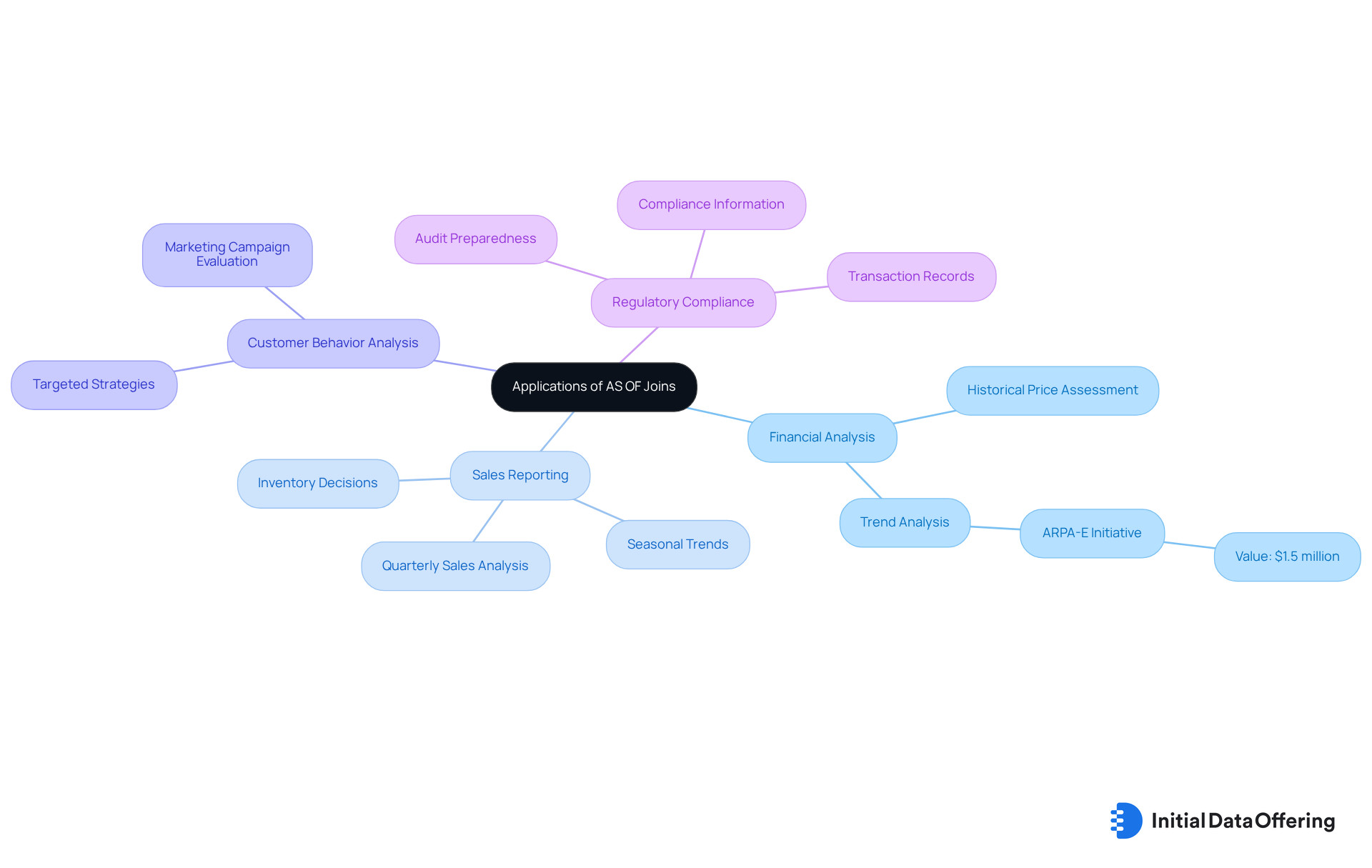Master AS OF Join Techniques for Effective Data Analysis

Master AS OF Join Techniques for Effective Data Analysis
Overview
This article delves into the mastery of AS OF join techniques, a crucial method for effective data analysis. By focusing on its capability to retrieve historical data at specific timestamps, we can appreciate its significance.
The article details the three modes of AS OF joins—backward, forward, and nearest—each offering unique advantages in data retrieval. For instance, in finance, these techniques can provide insights into past market behaviors, while in sales reporting, they can reveal trends over time.
Furthermore, customer behavior analysis benefits from these methods by allowing businesses to make informed decisions based on historical insights. Ultimately, mastering AS OF joins empowers professionals to leverage historical data for strategic advantages.
Introduction
The ability to analyze historical data is becoming increasingly vital in a world where decisions are often driven by real-time information. The AS OF join technique in SQL presents a powerful method for retrieving data as it existed at specific moments. This capability allows analysts to gain insights that are otherwise obscured by constant updates.
How can organizations effectively harness this technique to enhance their decision-making processes and ensure accurate reporting?
Exploring the intricacies of AS OF joins reveals not only their operational mechanics but also their transformative potential across various industries.
Understand the AS OF Join Concept
The AS OF join is a crucial SQL method that retrieves information as it existed at a specific moment. This capability is essential in environments where data is frequently updated. By enabling analysts to investigate the historical state of information, it offers a clearer context for decision-making. The phrase 'AS OF' indicates that the connection focuses on historical information rather than the present condition, which is vital for precise analysis.
There are three primary modes of AS OF join: backward, forward, and nearest. Each mode serves distinct analytical needs, allowing for flexibility in how data is compared based on timestamps. For instance, backward mode locates the last row in the other table where the timestamp is less than or equal to the timestamp in the current row. In contrast, forward mode identifies the next row where the timestamp is greater than or equal to the current row. Nearest mode finds the closest match, whether in the past or future.
Consider a sales table that logs transactions over time alongside a product table detailing product specifications. An AS OF join allows for the examination of sales information for a product as of join at the end of a specific month, even if the product details have since changed. This capability is crucial for accurate reporting and trend evaluation, enabling businesses to base their decisions on historical information instead of potentially misleading current figures.
The significance of historical information in SQL analysis cannot be overstated. It enables organizations to monitor performance, recognize trends, and make informed strategic choices. Real-world applications of the AS OF connection include its use in financial reporting, where analysts match trades with market quotes to evaluate trading strategies and market dynamics. Additionally, the AS OF connection is essential in merging diverse sensor information in IoT applications, offering a cohesive perspective on infrastructure health. By utilizing the AS OF connection, businesses can gain deeper insights into their data, ultimately leading to more informed and effective decision-making. As Adam Morton aptly states, "The AS OF connection is not just a method but a pathway to deeper insights and more informed decisions.

Implement AS OF Joins in Your Queries
To implement AS OF joins in your SQL queries, follow these steps:
-
Identify Your Tables: Start by determining which tables you need to connect. For example, you might have a
salestable and aproductstable. This initial step is crucial as it sets the foundation for your query. -
Define the Temporal Dimension: Next, establish the temporal dimension you wish to analyze. This could be a specific date or a range of dates, which is essential for understanding the context of your data at a particular point in time.
-
Write the SQL Query: Use the following template to create your AS OF join:
SELECT s.*, p.* FROM sales s JOIN products p AS OF TIMESTAMP 'YYYY-MM-DD HH:MM:SS' ON s.product_id = p.product_id;Make sure to replace 'YYYY-MM-DD HH:MM:SS' with your desired timestamp. This template provides a clear structure for your query, ensuring accuracy in your data retrieval.
-
Execute the Query: Once your query is written, run it in your SQL environment to obtain the information as of join at the specified time. Executing the query allows you to see the data in the context you are analyzing.
-
Analyze the Results: Finally, review the output to ensure it meets your analytical needs. This information can now be utilized for reporting or additional examination, providing valuable insights into your data trends.
By following these steps, you can effectively leverage AS OF join to gain a deeper understanding of your datasets.

Explore Real-World Applications of AS OF Joins
As of join, connections possess numerous applications across various sectors, providing valuable insights for data analysis. These connections serve as a vital tool for organizations seeking to enhance their decision-making processes. Here are a few examples:
-
Financial Analysis: In finance, analysts often need to assess the performance of stocks or portfolios at specific points in time. As of join, connections allow them to access historical prices and compare them with current values to assess trends. For example, the ARPA-E initiative, worth more than $1.5 million, highlights the significance of precise information analysis in financial decision-making, underscoring the importance of accurate data.
-
Sales Reporting: Companies can utilize as of join connections to examine sales information for particular products at the conclusion of each quarter. This analysis helps in understanding seasonal trends and making informed inventory decisions, which is crucial for optimizing sales strategies. How can your organization leverage this data to improve sales performance?
-
Customer Behavior Analysis: Marketers can examine customer interactions and purchases as they were on a specific date, enabling them to evaluate the effect of marketing campaigns over a duration. This capability is essential for enhancing targeted strategies and improving customer engagement. What insights can be drawn from past customer behavior to inform future campaigns?
-
Regulatory Compliance: Firms in regulated sectors can utilize connections as of join to preserve precise records of transactions and compliance information at particular moments, which is essential for audits and reporting. As pointed out by NREL researcher David Sickinger, "Precise information analysis is essential for ensuring compliance and making informed decisions."
By utilizing data as of join, organizations can gain deeper insights into their data, leading to more informed decision-making and strategic planning. Additionally, IDO's commitment to curating unique datasets, such as Alternative Data, Fundamentals Data, and ESG Data, supports these analytical efforts. These high-quality resources enhance the effectiveness of the as of join, ultimately driving better business outcomes.

Conclusion
The exploration of AS OF join techniques underscores their pivotal role in effective data analysis, particularly in environments where data is constantly evolving. This SQL method empowers analysts to retrieve historical data, offering a clearer context for decision-making. By focusing on the state of information at specific moments, AS OF joins enable organizations to make informed choices based on accurate historical insights rather than potentially misleading current data.
Throughout the article, key aspects of AS OF joins were discussed, including their three primary modes—backward, forward, and nearest—each tailored to meet different analytical needs. Practical examples highlighted the significance of AS OF joins across various sectors, such as financial analysis, sales reporting, customer behavior evaluation, and regulatory compliance. The step-by-step guide for implementing AS OF joins further equips readers to leverage this powerful technique in their SQL queries, enhancing their data analysis capabilities.
In a data-driven landscape, the ability to analyze information as it existed at a specific time is invaluable. Organizations that harness the power of AS OF joins can uncover deeper insights, optimize their decision-making processes, and ultimately drive better business outcomes. Embracing these techniques not only enhances analytical precision but also opens the door to more strategic planning and informed decision-making across various industries.
Frequently Asked Questions
What is the AS OF join concept in SQL?
The AS OF join is a SQL method that retrieves information as it existed at a specific moment, allowing analysts to investigate the historical state of information, which is essential for precise analysis in frequently updated data environments.
What are the primary modes of AS OF join?
The three primary modes of AS OF join are backward, forward, and nearest. Each mode serves different analytical needs based on timestamps.
How does the backward mode of AS OF join work?
The backward mode locates the last row in the other table where the timestamp is less than or equal to the timestamp in the current row.
How does the forward mode of AS OF join function?
The forward mode identifies the next row where the timestamp is greater than or equal to the current row.
What does the nearest mode of AS OF join do?
The nearest mode finds the closest match, whether in the past or future, based on timestamps.
Can you provide an example of how AS OF join is used?
An example is examining sales information for a product at the end of a specific month, even if the product details have since changed, allowing for accurate reporting and trend evaluation.
Why is historical information important in SQL analysis?
Historical information enables organizations to monitor performance, recognize trends, and make informed strategic choices, which is crucial for effective decision-making.
What are some real-world applications of the AS OF join?
Real-world applications include financial reporting, where analysts match trades with market quotes, and in IoT applications, where it helps merge diverse sensor information for a cohesive view of infrastructure health.